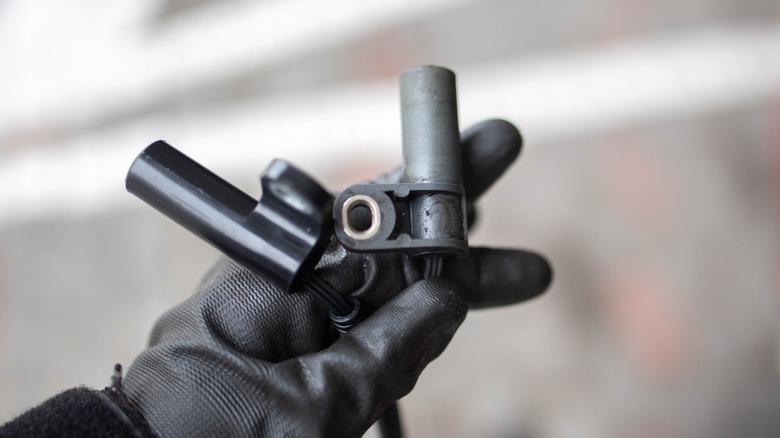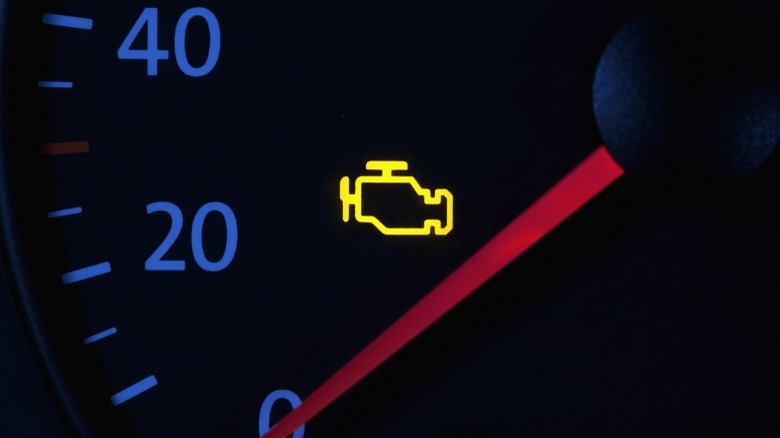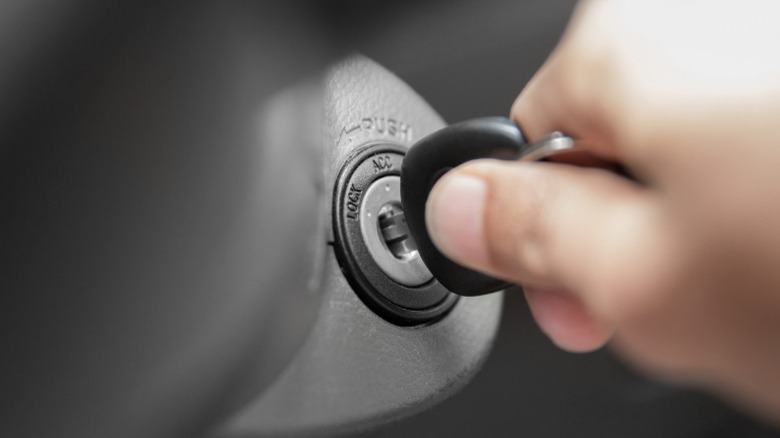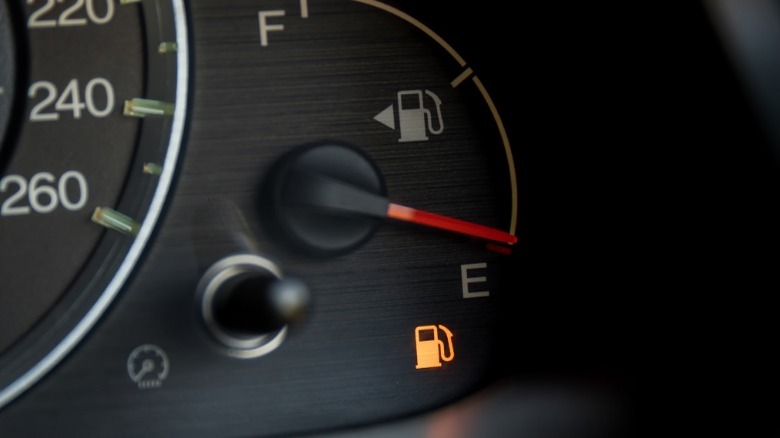5 Signs Your Engine's Crankshaft Position Sensor Is Bad
Two of the most critical components that help power your car's internal combustion engine are the crankshaft and the camshaft(s). The two parts are vital for sending power to various areas of your vehicle, including the engine accessory systems, the transmission, the motor's intake and exhaust valves, and much more. But despite their importance and the massive responsibility that these components have, they can't function on their own.
As is the case with nearly every other component of your car, the crankshaft and camshaft(s) belong to a larger system of parts that work together to send you down the road. The crankshaft position sensor is a less well-known component, but it works hand-in-hand with the crankshaft and the car's computer to keep the engine running smoothly and properly. The sensor's job is to monitor the movement of the crankshaft and relay that information to the car's computer or electronic control unit (ECU). The computer then uses that data to synchronize things like fuel injection and ignition timing, allowing multiple systems to operate together harmoniously to power your vehicle.
If the sensor fails, the entire combustion process can be disrupted, and you may experience an array of mechanical issues that prevent you from using your car. What are those issues? Let's find out. As a former professional auto repair technician and a lifelong gearhead, I'll break down the most common signs of trouble with your car's crankshaft position sensor. So, from a check engine light to difficulty starting your engine, here are five signs that your engine's crankshaft position sensor is bad.
The check engine light appears on your dash
One of the most prevalent symptoms of a faulty or failing crankshaft position sensor is an illuminated check engine light. Your car can display a lot of dashboard warning lights, each with its own meaning and ranging in severity from minor to extreme. However, one of the most common and misunderstood of those lights is the check engine light. It can appear for a vast number of reasons and indicates an error or malfunction somewhere in your vehicle.
You may see the check engine light on your dash if your car's ECU detects a problem with the crankshaft position sensor. That's because as the ECU monitors the sensor and interprets the data that it collects, it's also tracking the data in order to identify errors or erratic behavior. If the computer detects that the crankshaft position sensor is sending inconsistent information or strange signals, or if the sensor stops sending data altogether, it may trigger the check engine light. If the light does appear, though, you'll need to use an OBDII scan tool to read the diagnostic trouble codes (DTCs) stored by the system. Depending on your car's age and its make and model, you may be able to read the DTCs without a code reader. However, in most cases, you will need to use a scan tool to understand exactly why your vehicle's check engine light is lit.
You struggle to start the engine
Another problem that you may experience if your crankshaft position sensor is failing is difficulty starting your engine. We mentioned that the crankshaft position sensor is a vital component that helps various other parts to function properly. Remember that data that the sensor collects and sends to the ECU? Well, the ECU uses that information to control things like ignition timing, fuel injection, and the engine RPM. While the ignition system may contain parts like the spark plugs, distributor, and coil packs, depending on the vehicle, the fuel injection system includes the injectors, fuel pump, fuel pressure regulator, and various other components. When it comes to cranking up the motor, the ignition timing system and fuel injection system are critical, and each plays a vital role in starting the engine and keeping it running.
If the crankshaft position sensor is damaged or malfunctioning, it may send incorrect or inaccurate data to the ECU, or it may send nothing at all. Either way, when the sensor isn't sending the proper signals, the computer may be unable to control the ignition timing and fuel injection, or it may do so erratically or at the wrong time. When this occurs, you'll likely experience problems starting the engine, which may translate to a motor that takes a long time to crank or one that fails to start altogether. Remember, though, that various issues can prevent your car from starting. If you have problems starting your engine, you should visit a professional mechanic for an inspection and diagnosis.
Your car stalls while driving
One of the more frustrating symptoms of a bad crankshaft position sensor is engine stalling. Sure, not being able to start your car is a royal pain, but your vehicle dying in the middle of a busy intersection is another beast entirely. Not only is it inconvenient and embarrassing, but your engine stalling in traffic can be extremely dangerous.
This problem is likely to occur if your crankshaft position sensor is failing but not completely dead yet. As mentioned above, the sensor sends information about the crankshaft's movement and position to the ECU. The ECU then uses that information to manage things like ignition timing and fuel injection. While the ignition and fuel injection systems are both critical for starting your car, they're also vital for keeping it running.
When the crankshaft position sensor is starting to fail, it may function well enough to start your motor. However, it may be unable to continue sending accurate data for the entire time you're driving your car. When that occurs, the ignition timing and injection systems can fail, sending incorrect amounts of fuel to the engine or allowing the spark plugs to stop igniting the air and fuel mixture inside the combustion chambers. If that happens while you're driving or idling at an intersection, your car might stall out or die, leaving you stranded and in a dangerous situation in the middle of traffic.
You experience performance problems
Another problem you may experience if your crankshaft position sensor is bad or failing is a drop in your car's performance. However, that can mean a few different things. The most common types of performance issues you may face as the result of a faulty crankshaft position sensor include difficulty accelerating, a rough engine idle, strange vibrations, and engine misfires.
These issues are likely to occur if your crankshaft position sensor is failing and sending incorrect or erratic data to the ECU. Similar to previous symptoms discussed above, these performance problems — when caused by a bad crankshaft position sensor — are the result of the ECU's inability to regulate and control the ignition timing, fuel injection, and RPM properly. That can lead to a range of problems, but you're most likely to experience the issues described above, like misfires, a rough idle, difficulty accelerating, and more. However, you should keep in mind that these problems can be signs of various issues. If you experience them yourself, you should stop driving when it's safe to do so to avoid accidents or dangerous situations and prioritize visiting a professional mechanic for diagnosis and repair.
Your fuel economy drops
Another symptom that drivers frequently experience when their crankshaft position sensors are failing is a drop in fuel economy. Not only does that mean increased trips to the pump, which can be highly inconvenient, but can also mean a dent in your wallet and unexpected breakdowns.
A drop in gas mileage may occur when your crankshaft position sensor is malfunctioning and sending inaccurate data to the car's ECU. When that occurs, the computer will be unable to control the fuel injection system properly, which can cause the fuel injectors to activate at the wrong time, resulting in a noticeable drop in fuel economy. Furthermore, a faulty or failing crankshaft position sensor can also negatively affect other fuel-saving systems if your car has them. Things like variable valve timing and variable displacement systems operate based, in part, on the data collected by the crankshaft position sensor. If the sensor fails, it will likely disrupt those systems in addition to causing the other symptoms already discussed, which can cause an even greater drop in gas mileage and a bigger dent in your bank account.





